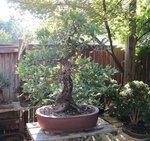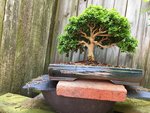markyscott
Imperial Masterpiece
Has anyone done a natural spreading to the ground of a cluster? Does anyone know of one? This is the image that’s anti-bonsai that I want to miniaturize. I love live oaks like this!
This is all true. I just see a lot of people saying various things aren’t “bonsai” which is why I put it in quotes. In particular Peter Chan is a bit of mix. He’s accepting of what others want their trees to look like but prefers more traditional in the videos I’ve seen. I don’t want to alienate anyone, just I feel my vision of what the live oak look I want is against the “rules” most people judge bonsai by. But if you guys say it’s ok then I am impressed with all of your character and happy that I’m here. I am perfectly willing to put 50 years in to the project. I have some ideas that once I get my live oak saplings I’ll run by everyone.
Conferring your impression of an old southern live oak in bonsai would be an interesting project. I’m not sure that using a live oak to execute it would be the best option, but who knows. I might try with a chinese elm - one could imagine it as a kind of an informal broom style but build the branch structure in the way you see your live oak growing.
S







